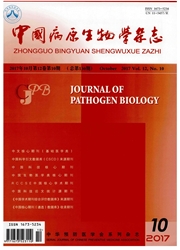

 中文摘要:
中文摘要:
目的寻找曼氏迭宫绦虫裂头蚴感染早期诊断抗原。方法从野蛙体内收集曼氏迭宫绦虫裂头蚴,经口接种感染20只昆明小鼠,每只小鼠接种2条裂头蚴,感染后6~28d隔天尾静脉采血,采用ELISA检测抗裂头蚴抗体;应用双向电泳(two—dimensionalelectrophoresis,2-DE)与Westernblot对裂头蚴可溶性抗原进行分析。结果裂头蚴感染后8d,小鼠血清特异抗体阳性率为10%(2/20),感染后14d特异抗体阳性率达100%。2-DE显示,裂头蚴可溶性抗原有255±6个蛋白点,分子质量主要集中在25~117ku,其中〉44ku的蛋白点有171±9个,占总蛋白点数的67.1%;等电点(pI)范围为4~7,其中227个蛋白点集中在pI5~6.5,占蛋白点总数的89.1%。Westernblot检测有14个蛋白点可被感染曼氏迭宫绦虫裂头蚴14d的小鼠血清识别,其分子质量集中在82、45、36、34及25ku;1~14号蛋白点所对应的pI值分别为5.93、6.06、6.17、6.30、6.39、5.82、6.01、6.17、5.69、5.46、5.63、6.1、5.71、6.19。结论曼氏迭宫绦虫裂头蚴可溶性抗原分子质量主要集中在25~117ku,pI值集中在5.0~6.5。感染14d的小鼠血清识别的裂头蚴蛋白可作为裂头蚴感染早期诊断候选抗原。
 英文摘要:
英文摘要:
Objective To identify antigens for early diagnosis of infection with Spirometra mansoni spargana. Methods Plerocercoids (spargana) of Spirornetra mansoni were collected and used to orally infect 20 Kunming mice with 2 spar- gana per mouse. Blood from the tail vein was collected every other day from day 6-day 28 post-infection (dpi), and anti- sparganum antibodies were assayed using ELISA. The soluble antigens of spargana were analyzed using two dimensional electrophoresis (2-DE)and Western blotting. Results Infected mice tested positive for anti-sparganum antibodies at a rate of 10% (2/20) at 8 dpi and up to 100% (20/20) at 14 dpi. In 2-DE, 255-6 protein spots in total were detected. These spots mainly had a molecular weight of 25-117 ku and an isoelectric point (pI) ranging from 4-7. Of the protein spots, 171±9 (67%) had a molecular weight of more than 44 ku, and 227 (89.1%) had a pI ranging from 5.0-6.5. Western blotting revealed that 14 protein spots were recognized by infected sera at 14 dpi but did not react to sera from healthy mice. The 14 protein spots were mostly concentrated at 82, 45, 36, 34, and 25 ku and had a corresponding pI of 5.93, 6.06, 6.17, 6.30, 6.39, 5.82, 6.01, 6.17, 5.69, 5.46, 5.63, 6.1, 5.71, and6.19. Conclusion Themolecu- lar weight of S. rnansoni soluble antigens mostly ranged from 25-117 ku and had a pI ranging from 4-7. The sparga- hum proteins recognized by sera from infected at 14 dpi might serve as candidate antigens for early diagnosis of spargano- sis.
 同期刊论文项目
同期刊论文项目
 同项目期刊论文
同项目期刊论文
 Analysis of structures, functions and epitopes of cysteine protease from Spirometra erinaceieuropaei
Analysis of structures, functions and epitopes of cysteine protease from Spirometra erinaceieuropaei Characterisation of the relationship between Spirometra erinaceieuropaei and Diphyllobothrium specie
Characterisation of the relationship between Spirometra erinaceieuropaei and Diphyllobothrium specie Identification of early diagnostic antigens from spirometra erinaceieuropaei sparganum soluble prote
Identification of early diagnostic antigens from spirometra erinaceieuropaei sparganum soluble prote Cutaneous gnathostomiasis with recurrent migratory nodule and persistent eosinophilia: a case report
Cutaneous gnathostomiasis with recurrent migratory nodule and persistent eosinophilia: a case report Analysis of structures, functions, and epitopes of cysteine protease from Spirometra erinaceieuropae
Analysis of structures, functions, and epitopes of cysteine protease from Spirometra erinaceieuropae Molecular characterization of a Spirometra mansoni antigenic polypeptide gene encoding a 28.7 kDa pr
Molecular characterization of a Spirometra mansoni antigenic polypeptide gene encoding a 28.7 kDa pr Characterization of Spirometra erinaceieuropaei Plerocercoid Cysteine Protease and Potential Applica
Characterization of Spirometra erinaceieuropaei Plerocercoid Cysteine Protease and Potential Applica Serodiagnosis of sparganosis by ELISA using recombinant cysteine protease of Spirometra erinaceieuro
Serodiagnosis of sparganosis by ELISA using recombinant cysteine protease of Spirometra erinaceieuro Levels of sparganum infections and phylogenetic analysis of the tapeworm Spirometra erinaceieuropaei
Levels of sparganum infections and phylogenetic analysis of the tapeworm Spirometra erinaceieuropaei Phylogenetic location of the Spirometra sparganum isolates from China, based on sequences of 28S rDN
Phylogenetic location of the Spirometra sparganum isolates from China, based on sequences of 28S rDN 期刊信息
期刊信息
